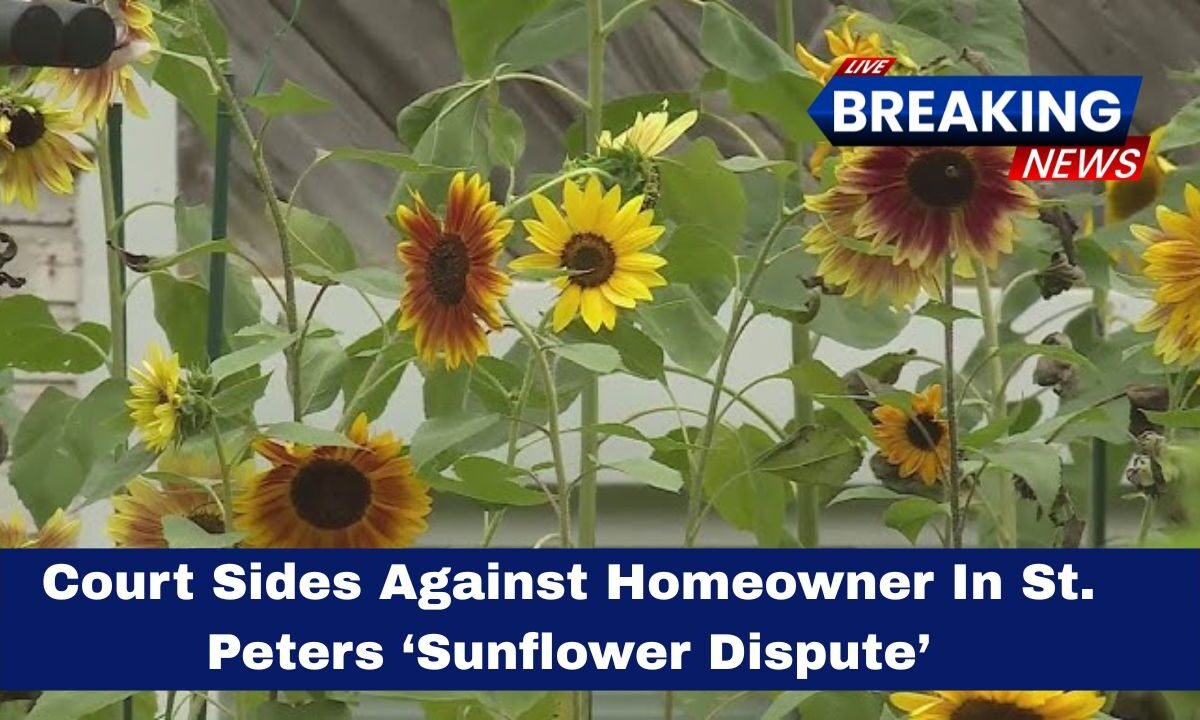On October 14, 2025, a municipal judge in St. Peters, Missouri delivered a ruling against resident Chris Bank, holding that his front-yard sunflower garden violates city ordinance.
The court classified his sunflowers as a “crop” and determined that his garden exceeds the 10 percent yard coverage maximum allowed under city regulations.
Bank says he will appeal the decision to St. Charles County.
Court’s Decision
The judge sided with the City of St. Peters, agreeing that Bank’s sunflowers must be treated as a crop under municipal code.
The city ordinance restricts crops (including sunflowers under the city’s interpretation) to no more than 10 percent of a lot’s area.
The court found that Bank’s sunflower planting covers in excess of that limit, thus violating the code.
Background and Dispute Timeline
The conflict has evolved over several years, marked by shifting enforcement standards. Initially, city officials referenced a grass-to-flower ratio metric in notices to Bank.
Later, the city reclassified the sunflowers as a crop, triggering the stricter 10 percent cap standard. Bank contends that changes in the city’s interpretations over time created confusion and unfair enforcement.
Neighbors submitted complaints over the visual scope of the display, describing the sunflower garden as excessive.
On the other side, some supporters backed Bank, arguing that municipal enforcement was overly rigid or selectively applied.
Bank claims he has already spent about $30,000 defending his garden through municipal hearings and settlements.
He maintains he does not harvest or sell seeds; rather, the sunflowers naturally wilt seasonally and were planted as a memorial to a loved one.
Key Facts
| Item | Detail |
|---|---|
| Location | St. Peters, St. Charles County, Missouri |
| Homeowner | Chris Bank |
| Main Issue | City treats sunflowers as a crop, limited to 10% yard coverage |
| Court Ruling (Oct 14, 2025) | Judge ruled against the homeowner; garden exceeds 10 percent limit |
| Earlier Standard | Enforcement initially applied a grass-to-flower ratio |
| Neighbor Complaints | Multiple complaints lodged about scale and appearance |
| Homeowner’s Position | Sunflowers as a memorial, not harvested, seasonal die-back |
| Next Step | Appeal to St. Charles County court |
| Estimated Legal Cost | Around $30,000 in prior proceedings |
Why This Case is Significant
This legal battle highlights a growing tension between local aesthetic ordinances and resident efforts to plant pollinator-friendly, naturalized gardens or memorial displays.
The city’s 10 percent cap, if applied broadly, could sharply restrict such plantings—even when no commercial harvesting is involved.
Furthermore, the discrepancy between earlier enforcement standards and newer interpretations raises questions about due process and fair notice.
Does a homeowner have a right to rely on earlier rules? And when may a municipality retroactively change its classification of vegetation from “ornamental” to “crop”?
The looming appeal will test how courts balance municipal zoning and beautification policies against individual property rights, particularly where noncommercial landscaping is concerned.
Next Moves by the Homeowner
Chris Bank plans to appeal beyond the municipal level to a broader court in St. Charles County, where he will seek a jury trial.
He says he is willing to comply with a lawful court ruling, but believes he deserves a more impartial forum.
The appeal may delve into legal definitions of “crop” versus “landscaping” and whether the city’s enforcement is constitutionally sound.
The St. Peters court’s ruling against Chris Bank marks a pivotal moment in the intersection of local codes, landscaping rights, and municipal power.
By classifying sunflowers—a traditionally ornamental plant—as a “crop” and enforcing a 10 percent yard coverage cap, the city has drawn a line that could affect not only Bank’s memorial garden but similar naturalized or pollinator-friendly plantings in the future.
With a formal appeal pending, the next legal chapter may decide whether individual homeowners can keep their gardens blooming beyond a rigid numeric limit.




